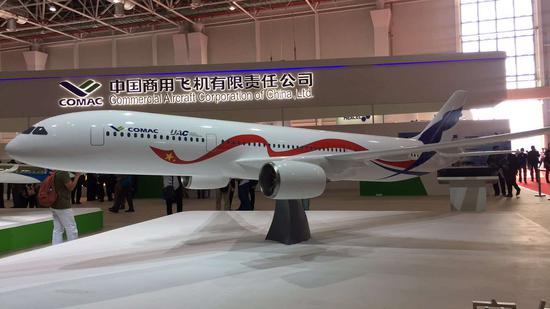- Joined
- Aug 8, 2008
- Messages
- 6,070
- Points
- 83
http://mil.news.sina.com.cn/jssd/2018-05-21/doc-ihaturft6291735.shtml
中国新材料获突破强度是钢60倍 或助大飞机弯道超车
中国新材料获突破强度是钢60倍 或助大飞机弯道超车
0
据《科技日报》16日报道,清华大学两个团队合作,在超级强度材料上获得重大突破:在世界上首次制备了接近单根碳纳米管理论强度的1厘米超长碳纳米管管束,其拉伸强度超越已知所有其他纤维材料,拉伸强度提高到80GPa以上。

碳纳米管被认为是目前发现的最强的几种材料之一,被认为是制作太空电梯的理想材料。然而这种高强度材料,只在微观的尺度,例如纳米级别才显示出超强度的特性,然而在可见的宏观尺度,这种碳纳米材料就会性能迅速下降,因为旧有的制备技术形成的碳纳米管有缺陷,很容易在拉力作用下易从缺陷处断裂并极易相互滑移。

但是清华大学两个两个团队合作采用气流聚焦法,制备出了具有确定组成、结构完美且平行排列的厘米级连续超长碳纳米管管束,然后另辟蹊径,将管束的拉伸强度提高到80GPa以上,接近单根碳纳米管的拉伸强度,并证明随碳纳米管根数增加,强度可以保持。

80GPa是拉伸强度的单位,可能单纯的数字并不能显示其威力。那么我们可以列举一些当前的材料来进行对比。例如目前市场上强度最好的碳纤维日本东丽公司的T1000,其拉伸强度是多少呢?只有7.02GPa,该公司研制的实验室中的最先进碳纤维也只有9GPa。一些超级汽车钢、超高强度钢板的拉伸强度也就是1.5-2GPa。我国的超长碳纳米管强度是目前材料的10-60倍。

复合材料应用于大飞机、大火箭领域已经是当前的潮流,其原因就在于碳纤维等复合材料重量很轻但强度却非常大,这就意味这这些航空航天装备在降低空重的同时,还具有更好的力学性能。这对于航空航天武器提高有效载荷具有决定性意义。而超长碳纳米管管束是现有最先进复合材料的10倍,就意味着性能会有颠覆性提升。中国研制的C-919大飞机、长征九号重型运载火箭性能就可能实现弯道超车。

此外,这些这些结构完美的碳纳米管还展示出了惊人的拉伸-复原的可逆性以及疲劳寿命,因此在机械能存储上具有极大的优势,其能量密度密还是功率密度,碳纳米管都远远超过了其他储能材料或设备。碳纳米管储存机械能的能量密度是飞轮储能密度的3倍,是锂离子电池储能密度的5-8倍,超过一般金属弹簧储能密度的25000倍。可以应用在电磁弹射、电磁炮、激光炮等能量武器上。

除了超高强度和超高储能,碳纳米管还具有独特的电学性质。碳纳米管电子器件具有尺寸小度快、功耗低等优势。在制造晶体管、存储器、逻辑电路、传感器等器件方而展示出了巨大的优势。事实上在2017年IBM就公开了碳纳米管生产技术,可令运算速度提升一千倍。北京大学电子系教授彭练矛带领团队成功使用新材料碳纳米管制造出芯片的核心元器件——晶体管,其工作速度3倍于英特尔最先进的14纳米商用硅材料晶体管。可以说中国两所大学研究人员对碳纳米管的研究,也为中国芯片发展指出了另一个方向。

材料科学是基础性科学,中国在很多核心技术方面存在短板,归根结底和材料科学研究不到位有很大关系。相反,只有加大在基础科研领域的投入,才能让中国实现真正的后发超越。越是我国可能被封锁、禁运、制裁、卡脖子的时候,我们越是应该注重基础科学的投入,只有这样才是打破封锁的唯一有力武器。(作者署名:诤闻军事)
China's new material has achieved a breakthrough strength of 60 times that of steel or has helped aircraft overtake the curve.
China's new material has achieved a breakthrough strength of 60 times that of steel or has helped aircraft overtake the curve.
0
According to the "Science and Technology Daily" report on the 16th, two teams of Tsinghua University cooperated to achieve a major breakthrough in super-strength materials: for the first time in the world, a 1 cm ultralong carbon nanotube bundle approaching the theoretical strength of a single carbon nanotube was prepared. The tensile strength exceeds that of all other known fiber materials, and the tensile strength is increased to more than 80 GPa.
Carbon nanotubes are considered to be one of the strongest materials discovered so far and are considered to be ideal materials for making space elevators. However, this high-strength material exhibits super-strength characteristics only at the microscopic scale, such as the nanometer level. However, at the visible macroscopic scale, this carbon nanomaterial will rapidly degrade because of the old preparation technology. Carbon nanotubes are defective, they are easily broken from the defects under the action of tensile force and are easily slippery with each other.
However, the two teams of Tsinghua University used the air flow focusing method to prepare a centimeter continuous ultra-long carbon nanotube tube bundle with a definite composition, structure and parallel arrangement, and then found another way to increase the tensile strength of the tube bundle to more than 80 GPa. It is close to the tensile strength of a single carbon nanotube, and it has been shown that the strength can be maintained as the number of carbon nanotubes increases.
80GPa is the unit of tensile strength, and a simple number may not show its power. Then we can compare some of the current materials. For example, what is the tensile strength of T1000, Japan's best-strength carbon fiber, currently on the market? Only 7.02GPa, the company developed the most advanced carbon fiber in the laboratory only 9GPa. The tensile strength of some super automobile steels and ultra high strength steel plates is 1.5-2 GPa. The strength of ultra-long carbon nanotubes in our country is 10-60 times that of current materials.
The application of composite materials in the field of large aircrafts and big rockets is the current trend. The reason for this is that carbon fiber and other composite materials are light in weight, but their strength is very large. This means that these aerospace equipment have the ability to reduce empty weight while also having Better mechanical properties. This is of decisive significance for increasing the payload of aerospace weapons. The bundle of ultra-long carbon nanotubes is 10 times that of the most advanced composite materials, which means that the performance will be subversive. The performance of the Chinese-developed C-919 large-scale aircraft and the Long March 9 heavy-lift launcher may lead to overtaking.
In addition, these well-structured carbon nanotubes also exhibit an amazing stretch-recovery reversibility and fatigue life, so they have a great advantage in mechanical energy storage, and their energy density density or power density, carbon nanotubes are Far more than other energy storage materials or equipment. The energy density of carbon nanotube storage mechanical energy is 3 times of the flywheel energy storage density, and it is 5-8 times of the energy storage density of lithium ion battery, more than 25000 times of the energy storage density of general metal spring. Can be applied to electromagnetic bombs, electromagnetic guns, laser cannons and other energy weapons.
In addition to ultra-high strength and ultra-high energy storage, carbon nanotubes also have unique electrical properties. Carbon nanotube electronic devices have the advantages of small size, low power consumption, and the like. In the manufacture of transistors, memory, logic circuits, sensors and other devices have shown great advantages. In fact, in 2017, IBM disclosed carbon nanotube production technology, which can increase the speed of computing by a thousand times. Peng Lianmao, a professor in the Department of Electronics at Peking University, led the team to successfully use the new material, carbon nanotubes, to create the core component of the chip, the transistor, which is three times faster than Intel’s most advanced 14-nm commercial silicon transistor. It can be said that the study of carbon nanotubes by researchers from two universities in China points to another direction for the development of Chinese chips.
Material science is a basic science. China has shortcomings in many core technologies. In the final analysis, there is a great relationship between materials science research and the lack of scientific research. On the contrary, only increasing investment in basic scientific research can enable China to achieve true backward surpassing. The more times China can be blocked, embargoed, sanctioned, or stuck, the more we should focus on basic scientific input, and the only way to break the embargo is to use the only powerful weapon. (Author's signature: Gossip military)
中国新材料获突破强度是钢60倍 或助大飞机弯道超车
中国新材料获突破强度是钢60倍 或助大飞机弯道超车
0
据《科技日报》16日报道,清华大学两个团队合作,在超级强度材料上获得重大突破:在世界上首次制备了接近单根碳纳米管理论强度的1厘米超长碳纳米管管束,其拉伸强度超越已知所有其他纤维材料,拉伸强度提高到80GPa以上。

碳纳米管被认为是目前发现的最强的几种材料之一,被认为是制作太空电梯的理想材料。然而这种高强度材料,只在微观的尺度,例如纳米级别才显示出超强度的特性,然而在可见的宏观尺度,这种碳纳米材料就会性能迅速下降,因为旧有的制备技术形成的碳纳米管有缺陷,很容易在拉力作用下易从缺陷处断裂并极易相互滑移。

但是清华大学两个两个团队合作采用气流聚焦法,制备出了具有确定组成、结构完美且平行排列的厘米级连续超长碳纳米管管束,然后另辟蹊径,将管束的拉伸强度提高到80GPa以上,接近单根碳纳米管的拉伸强度,并证明随碳纳米管根数增加,强度可以保持。

80GPa是拉伸强度的单位,可能单纯的数字并不能显示其威力。那么我们可以列举一些当前的材料来进行对比。例如目前市场上强度最好的碳纤维日本东丽公司的T1000,其拉伸强度是多少呢?只有7.02GPa,该公司研制的实验室中的最先进碳纤维也只有9GPa。一些超级汽车钢、超高强度钢板的拉伸强度也就是1.5-2GPa。我国的超长碳纳米管强度是目前材料的10-60倍。

复合材料应用于大飞机、大火箭领域已经是当前的潮流,其原因就在于碳纤维等复合材料重量很轻但强度却非常大,这就意味这这些航空航天装备在降低空重的同时,还具有更好的力学性能。这对于航空航天武器提高有效载荷具有决定性意义。而超长碳纳米管管束是现有最先进复合材料的10倍,就意味着性能会有颠覆性提升。中国研制的C-919大飞机、长征九号重型运载火箭性能就可能实现弯道超车。

此外,这些这些结构完美的碳纳米管还展示出了惊人的拉伸-复原的可逆性以及疲劳寿命,因此在机械能存储上具有极大的优势,其能量密度密还是功率密度,碳纳米管都远远超过了其他储能材料或设备。碳纳米管储存机械能的能量密度是飞轮储能密度的3倍,是锂离子电池储能密度的5-8倍,超过一般金属弹簧储能密度的25000倍。可以应用在电磁弹射、电磁炮、激光炮等能量武器上。

除了超高强度和超高储能,碳纳米管还具有独特的电学性质。碳纳米管电子器件具有尺寸小度快、功耗低等优势。在制造晶体管、存储器、逻辑电路、传感器等器件方而展示出了巨大的优势。事实上在2017年IBM就公开了碳纳米管生产技术,可令运算速度提升一千倍。北京大学电子系教授彭练矛带领团队成功使用新材料碳纳米管制造出芯片的核心元器件——晶体管,其工作速度3倍于英特尔最先进的14纳米商用硅材料晶体管。可以说中国两所大学研究人员对碳纳米管的研究,也为中国芯片发展指出了另一个方向。

材料科学是基础性科学,中国在很多核心技术方面存在短板,归根结底和材料科学研究不到位有很大关系。相反,只有加大在基础科研领域的投入,才能让中国实现真正的后发超越。越是我国可能被封锁、禁运、制裁、卡脖子的时候,我们越是应该注重基础科学的投入,只有这样才是打破封锁的唯一有力武器。(作者署名:诤闻军事)
China's new material has achieved a breakthrough strength of 60 times that of steel or has helped aircraft overtake the curve.
China's new material has achieved a breakthrough strength of 60 times that of steel or has helped aircraft overtake the curve.
0
According to the "Science and Technology Daily" report on the 16th, two teams of Tsinghua University cooperated to achieve a major breakthrough in super-strength materials: for the first time in the world, a 1 cm ultralong carbon nanotube bundle approaching the theoretical strength of a single carbon nanotube was prepared. The tensile strength exceeds that of all other known fiber materials, and the tensile strength is increased to more than 80 GPa.
Carbon nanotubes are considered to be one of the strongest materials discovered so far and are considered to be ideal materials for making space elevators. However, this high-strength material exhibits super-strength characteristics only at the microscopic scale, such as the nanometer level. However, at the visible macroscopic scale, this carbon nanomaterial will rapidly degrade because of the old preparation technology. Carbon nanotubes are defective, they are easily broken from the defects under the action of tensile force and are easily slippery with each other.
However, the two teams of Tsinghua University used the air flow focusing method to prepare a centimeter continuous ultra-long carbon nanotube tube bundle with a definite composition, structure and parallel arrangement, and then found another way to increase the tensile strength of the tube bundle to more than 80 GPa. It is close to the tensile strength of a single carbon nanotube, and it has been shown that the strength can be maintained as the number of carbon nanotubes increases.
80GPa is the unit of tensile strength, and a simple number may not show its power. Then we can compare some of the current materials. For example, what is the tensile strength of T1000, Japan's best-strength carbon fiber, currently on the market? Only 7.02GPa, the company developed the most advanced carbon fiber in the laboratory only 9GPa. The tensile strength of some super automobile steels and ultra high strength steel plates is 1.5-2 GPa. The strength of ultra-long carbon nanotubes in our country is 10-60 times that of current materials.
The application of composite materials in the field of large aircrafts and big rockets is the current trend. The reason for this is that carbon fiber and other composite materials are light in weight, but their strength is very large. This means that these aerospace equipment have the ability to reduce empty weight while also having Better mechanical properties. This is of decisive significance for increasing the payload of aerospace weapons. The bundle of ultra-long carbon nanotubes is 10 times that of the most advanced composite materials, which means that the performance will be subversive. The performance of the Chinese-developed C-919 large-scale aircraft and the Long March 9 heavy-lift launcher may lead to overtaking.
In addition, these well-structured carbon nanotubes also exhibit an amazing stretch-recovery reversibility and fatigue life, so they have a great advantage in mechanical energy storage, and their energy density density or power density, carbon nanotubes are Far more than other energy storage materials or equipment. The energy density of carbon nanotube storage mechanical energy is 3 times of the flywheel energy storage density, and it is 5-8 times of the energy storage density of lithium ion battery, more than 25000 times of the energy storage density of general metal spring. Can be applied to electromagnetic bombs, electromagnetic guns, laser cannons and other energy weapons.
In addition to ultra-high strength and ultra-high energy storage, carbon nanotubes also have unique electrical properties. Carbon nanotube electronic devices have the advantages of small size, low power consumption, and the like. In the manufacture of transistors, memory, logic circuits, sensors and other devices have shown great advantages. In fact, in 2017, IBM disclosed carbon nanotube production technology, which can increase the speed of computing by a thousand times. Peng Lianmao, a professor in the Department of Electronics at Peking University, led the team to successfully use the new material, carbon nanotubes, to create the core component of the chip, the transistor, which is three times faster than Intel’s most advanced 14-nm commercial silicon transistor. It can be said that the study of carbon nanotubes by researchers from two universities in China points to another direction for the development of Chinese chips.
Material science is a basic science. China has shortcomings in many core technologies. In the final analysis, there is a great relationship between materials science research and the lack of scientific research. On the contrary, only increasing investment in basic scientific research can enable China to achieve true backward surpassing. The more times China can be blocked, embargoed, sanctioned, or stuck, the more we should focus on basic scientific input, and the only way to break the embargo is to use the only powerful weapon. (Author's signature: Gossip military)

